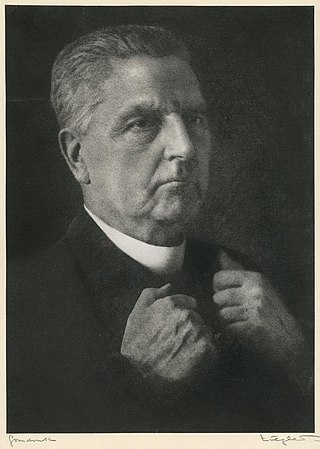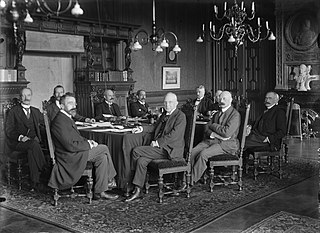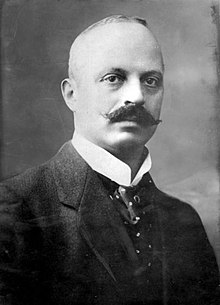
The Christian Democratic Appeal is a Christian-democratic political party in the Netherlands. It was originally formed in 1977 from a confederation of the Catholic People's Party, the Anti-Revolutionary Party and the Christian Historical Union; it has participated in all but three cabinets since it became a unitary party.

The Anti-Revolutionary Party was a Protestant conservative and Christian democratic political party in the Netherlands. The party was founded in 1879 by Abraham Kuyper, a neo-Calvinist theologian and minister. In 1980 the party merged with the Catholic People's Party (KVP) and the Christian Historical Union (CHU) to form the Christian Democratic Appeal (CDA).
The Catholic People's Party was a Catholic Christian democratic political party in the Netherlands. The party was founded in 1945 as a continuation of the Roman Catholic State Party, which was a continuation of the General League of Roman Catholic Caucuses. During its entire existence, the party was in government. In 1977, a federation of parties including the Catholic People's Party, the Anti-Revolutionary Party (ARP) and the Christian Historical Union (CHU) ran together under the Christian Democratic Appeal (CDA) banner. The three participating parties formally dissolved to form the CDA in 1980.

The Free-thinking Democratic League was a progressive liberal political party in the Netherlands. Established in 1901, it played a relatively large role in Dutch politics, supplying one Prime Minister, Wim Schermerhorn. The League is a predecessor of two of the major Dutch political parties, the conservative liberal People's Party for Freedom and Democracy (VVD) and the social democratic Labour Party (PvdA). The social liberal Democrats 66 also claims that it and the VDB are ideologically connected.

The Christian Historical Union was a Protestant Christian democratic political party in the Netherlands. The CHU is one of the predecessors of the Christian Democratic Appeal (CDA), into which it merged in September 1980.

JonkheerCharles Joseph Marie Ruijs de Beerenbrouck was a Dutch politician of the defunct Roman Catholic State Party (RKSP), later formed to the Catholic People's Party (KVP) now merged into the Christian Democratic Appeal (CDA). He served as Prime Minister of the Netherlands from 9 September 1918 until 4 August 1925 and from 10 August 1929 until 26 May 1933.

The General League of Roman Catholic Riding Associations, informally called the General League, was a Catholic political party in the Netherlands. It is one of the ancestors of the Christian Democratic Appeal, currently a major party in the Netherlands.
The Liberal State Party, "the Freedom League", was a conservative liberal political party in the Netherlands from 1921 to 1948. It is historically linked to the People's Party for Freedom and Democracy (VVD), a major Dutch political party.

The Hervormd Gereformeerde Staatspartij was a Dutch orthodox Protestant political party during the interbellum. For its orthodox political ideals and its refusal to cooperate in any cabinet, the party is called a testimonial party.

Petrus Josephus Mattheus "Piet" Aalberse Sr. was a Dutch politician of the defunct General League of Roman Catholic Caucuses (ABRK) later the Roman Catholic State Party (RKSP) and later co-founder of the Catholic People's Party (KVP) now merged into the Christian Democratic Appeal (CDA) party and jurist. He was granted the honorary title of Minister of State on 31 December 1934.

This article gives an overview of Christian democracy in the Netherlands, which is also called confessionalism, including political Catholicism and Protestantism. It is limited to Christian democratic parties with substantial support, mainly proved by having had a representation in parliament. The sign ⇒ means a reference to another party in that scheme.
Roman/Red is the nickname for a period in Dutch politics between approximately 1945 and 1958. This period was characterized by coalitions between the Catholic and social-democratic parties in the Netherlands and Belgium. "Roman" refers to the parties with Roman Catholic affiliation, and "red" refers to the colour associated with social democrats. During the Roman/Red period, the Catholic People's Party (KVP) and the social-democratic Labour Party (PvdA) formed the core of several 'Roman/Red' cabinets, led primarily by Willem Drees.

Mgr. mr. dr. Wilhelmus Hubertus (Wiel) Nolens was a Dutch politician and a Roman Catholic priest.

Charles Joseph Ignace Marie Welter was a Dutch politician and diplomat of the defunct General League of Roman Catholic Caucuses (ABRK) party later the Roman Catholic State Party (RKSP), the Catholic People's Party (KVP) and founder of Catholic National Party (KNP) before rejoining the Catholic People's Party now merged into the Christian Democratic Appeal (CDA) party and nonprofit director.

The Second De Geer cabinet, also called the First London cabinet, was the cabinet of the Netherlands from 10 August 1939 until 3 September 1940. The cabinet was formed by the political parties Roman Catholic State Party (RKSP), Social Democratic Workers' Party (SDAP), Anti-Revolutionary Party (ARP), Christian Historical Union (CHU) and the Free-thinking Democratic League (VDB) following the dismissal of the Fifth Colijn cabinet by Queen Wilhelmina on 27 July 1939. The national unity government became a War cabinet on 14 May 1940 following the German invasion and fled to London. The government-in-exile was dismissed by Queen Wilhelmina on 26 August 1940.

The Second Colijn cabinet was the cabinet of the Netherlands from 26 May 1933 until 31 July 1935. The cabinet was formed by the political parties Roman Catholic State Party (RKSP), Anti-Revolutionary Party (ARP), Christian Historical Union (CHU), Liberal State Party (LSP) and the Free-thinking Democratic League (VDB) after the election of 1933. The centre-right cabinet was a majority government in the House of Representatives. It was the second of five cabinets of Hendrikus Colijn, the Leader of the Anti-Revolutionary Party as Prime Minister.

The Third Ruijs de Beerenbrouck cabinet was the cabinet of the Netherlands from 10 August 1929 until 26 May 1933. The cabinet was formed by the political parties Roman Catholic State Party (RKSP), Anti-Revolutionary Party (ARP) and the Christian Historical Union (CHU) after the election of 1929. The centre-right cabinet was a majority government in the House of Representatives. It was the last of three cabinets of Charles Ruijs de Beerenbrouck, the Leader of the Roman Catholic State Party as Prime Minister.

The First Ruijs de Beerenbrouck cabinet was the cabinet of the Netherlands from 9 September 1918 until 18 September 1922. The cabinet was formed by the political parties Roman Catholic State Party (RKSP), Anti-Revolutionary Party (ARP) and the Christian Historical Union (CHU) after the election of 1918. The centre-right cabinet was a majority government in the House of Representatives. It was the first of three cabinets of Charles Ruijs de Beerenbrouck, the Leader of the Roman Catholic State Party as Prime Minister.

The Second Ruijs de Beerenbrouck cabinet was the cabinet of the Netherlands from 18 September 1922 until 4 August 1925. The cabinet was formed by the political parties Roman Catholic State Party (RKSP), Anti-Revolutionary Party (ARP) and the Christian Historical Union (CHU) after the election of 1922. The centre-right cabinet was a majority government in the House of Representatives and was a continuation of the previous Cabinet Ruijs de Beerenbrouck I. It was the second of three cabinets of Charles Ruijs de Beerenbrouck, the Leader of the Roman Catholic State Party as Prime Minister.

Laurentius Nicolaas Deckers was a Dutch politician and diplomat of the defunct Roman Catholic State Party (RKSP) and later co-founder of the Catholic People's Party (KVP) now merged into the Christian Democratic Appeal (CDA) party and agronomist.















